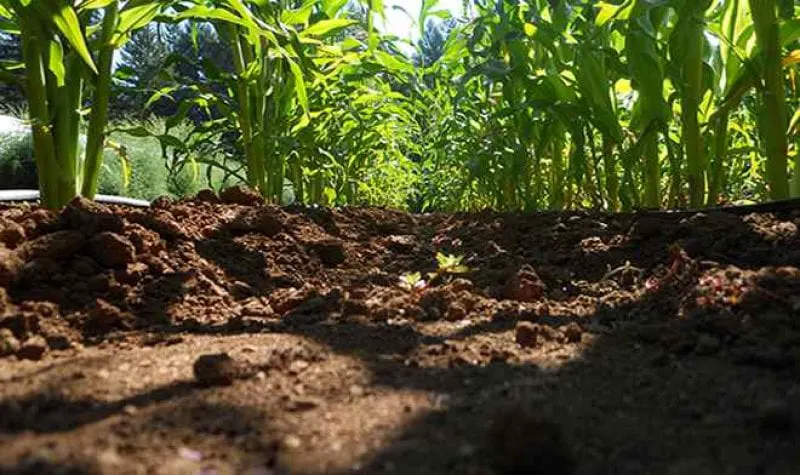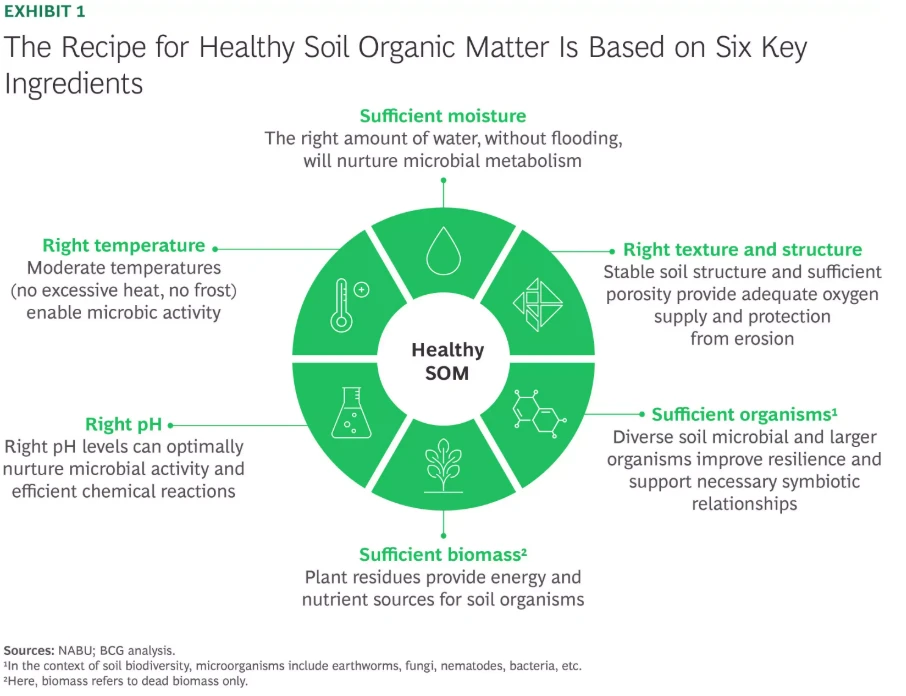What’s the recipe for healthier food? Healthier soil?
What’s the recipe for healthier food? Healthier soil?


Greater biodiversity is the key to healthier soil. And healthier soil is the key to a range of environmental and economic benefits. Here’s how to achieve them.
- Soil biodiversity plays a critical role not just in the production of food but in maintaining clean fresh water, recharging groundwater reserves, and collecting and storing carbon.
- Soil needs sufficient water, healthy living organisms and plant residue, and the right temperature—all benefits associated with regenerative agriculture.
- Increasing the health of the soil in Germany, for example, would lead to upward of €14 billion in economic benefits annually.
- All stakeholders must pay far more attention to the benefits of soil biodiversity and push for more research, supportive policies, and incentives.
Have you ever thought about the value of soil? It covers 25% of the earth’s surface. It supports all of our ecosystems, from farms and grazing land to rainforests and the vast northern taiga. It contains more carbon than the earth’s atmosphere and all its plant biomass combined. The amount of fresh water in soil that’s available to grow plants is 100 times greater than all the world’s lakes, rivers, and wetlands put together. Soil connects the lithosphere, atmosphere, hydrosphere, and biosphere. And 95% of the food we eat is dependent on it, making soil the single most important resource for agriculture to feed the world.
Yet despite soil’s importance, we are only just beginning to understand the science of it: its astonishing biodiversity when healthy and the role it plays not just in the production of food but in maintaining clean fresh water, recharging groundwater reserves, and collecting and storing the carbon that would otherwise keep warming the planet.
Maintaining healthy soil is a task not just for farmers and agricultural policymakers but also for food companies, grocers, and consumers.
What we have learned in our latest extensive research is not just about the conditions needed for the healthiest, most productive soil possible. Along with the environmental and nutritional benefits of healthy soil, the significant economic value gained by improving soil (upward of €14 billion a year in Germany alone) makes clear just how critical it is to strive in every way to optimize and maintain its health.
This is a task for all stakeholders—not just farmers and agricultural policymakers but also for food companies, grocers, and consumers. In this article we look at what makes healthy soil so critical to the well-being of the planet and how we can work together to capture its considerable economic value.

The amount and quality of the research that has been carried out on soil biodiversity to date lags far behind the major advances in above-ground plant research now taking place, from new breeding technologies to CRISPR-based gene editing.
This is an excerpt. Read the original post here

 | Videos | More... |

Video: Nuclear energy will destroy us? Global warming is an existential threat? Chemicals are massacring bees? Donate to the Green Industrial Complex!
 | Bees & Pollinators | More... |

GLP podcast: Science journalism is a mess. Here’s how to fix it

Mosquito massacre: Can we safely tackle malaria with a CRISPR gene drive?

Are we facing an ‘Insect Apocalypse’ caused by ‘intensive, industrial’ farming and agricultural chemicals? The media say yes; Science says ‘no’
 | Infographics | More... |

Infographic: Global regulatory and health research agencies on whether glyphosate causes cancer
 | GMO FAQs | More... |

Why is there controversy over GMO foods but not GMO drugs?

How are GMOs labeled around the world?

How does genetic engineering differ from conventional breeding?
 | GLP Profiles | More... |

Alex Jones: Right-wing conspiracy theorist stokes fear of GMOs, pesticides to sell ‘health supplements’




 A single high dose of LSD can ease anxiety and depression for months
A single high dose of LSD can ease anxiety and depression for months From plastic coasters to human hearts: Inside the race to print the human body
From plastic coasters to human hearts: Inside the race to print the human body CRISPR pork: U.S. approves first gene-edited pigs for consumption
CRISPR pork: U.S. approves first gene-edited pigs for consumption ‘SuperAgers’: Why some people have the brains and memory capacity of people decades younger
‘SuperAgers’: Why some people have the brains and memory capacity of people decades younger  Baby food panic, brought to you by trial lawyers hoping to prosecute by press release
Baby food panic, brought to you by trial lawyers hoping to prosecute by press release Viewpoint: Life and death decisions: RFK, Jr.’s shady FDA “expert panels” operate in secret with no transcripts or conflict of interest reviews
Viewpoint: Life and death decisions: RFK, Jr.’s shady FDA “expert panels” operate in secret with no transcripts or conflict of interest reviews From ‘Frankenfood’ to superfood: Can the purple tomato overcome GMO myths to win over consumers?
From ‘Frankenfood’ to superfood: Can the purple tomato overcome GMO myths to win over consumers? When farmers deny science: The hypocrisy hurting agriculture’s credibility
When farmers deny science: The hypocrisy hurting agriculture’s credibility
